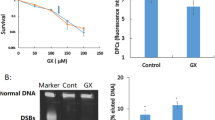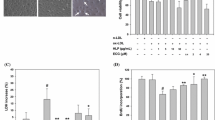Abstract
Both α-lipoic acid (LA) and ascorbic acid (vitamin C) have been shown to improve endothelial dysfunction, a precursor of atherosclerosis. Since oxidant stress can cause endothelial dysfunction, we tested the interaction and efficacy of these antioxidants in preventing oxidant damage to lipids due to both intra- and extracellular oxidant stresses in EA.hy926 endothelial cells. LA spared intracellular ascorbate in culture and in response to an intracellular oxidant stress induced by the redox cycling agent menadione. Extracellular oxidant stress generated by incubating cells for 2 h in with 0.2 mg/ml LDL and 5 μM Cu2+ caused a time-dependent increase of the lipid peroxidation product malondialdehyde in both cells and LDL, preceded by rapid disappearance of` α-tocopherol in LDL. α-Lipoic acid at concentrations of 40–80 μM blunted these effects. Similarly, intracellular ascorbate concentrations of 1–2 mM also prevented Cu2+-induced lipid peroxidation in LDL and cells. Cu2+-dependent oxidation of LDL in the presence of ascorbate-loaded cells decreased intracellular ascorbate by 20%, but this decrease was not reversed by LA. Both LA and ascorbate protect endothelial cells and LDL from either intra- or extracellular oxidant stress, but that LA does not spare ascorbate in oxidatively stressed cells.






Similar content being viewed by others
References
Michiels C (2003) Endothelial cell functions. J Cell Physiol 196:430–443
Ross R (1999) Atherosclerosis–an inflammatory disease. N Engl J Med 340:115–126
Steinberg D, Parthasarathy S, Carew TE et al (1989) Modifications of low-density lipoprotein that increase its atherogenicity. N Engl J Med 320:915–924
Steinbrecher UP, Parthasarathy S, Leake DS et al (1984) Modification of low density lipoprotein by endothelial cells involves lipid peroxidation and degradation of low density lipoprotein phospholipids. Proc Natl Acad Sci USA 81:3883–3887
Matsugo S, Konishi T, Matsuo D et al (1996) Reevaluation of superoxide scavenging activity of dihydrolipoic acid and its analogues by chemiluminescent method using 2-methyl-6-[p-methoxyphenyl]-3,7-dihydroimidazo-[1,2-a]pyrazine-3-one (MCLA) as a superoxide probe. Biochem Biophys Res Commun 227:216–220
Packer L, Witt EH, Tritschler HJ (1995) α-Lipoic acid as a biological antioxidant. Free Radic Biol Med 19:227–250
Jocelyn PC (1967) The standard redox potential of cysteine-cystine from the thiol-disulfide exchange reaction with glutathione and lipoic acid. Eur J Biochem 2:327–331
Han D, Handelman G, Marcocci L et al (1997) Lipoic acid increases de novo synthesis of cellular glutathione by improving cystine utilization. Biofactors 6:321–338
Roy S, Packer L (1998) Redox regulation of cell functions by α-lipoate: biochemical and molecular aspects. Biofactors 8:17–21
Kagan VE, Serbinova EA, Forte T et al (1992) Recycling of vitamin E in human low density lipoproteins. J Lipid Res 33:385–397
Niki E, Noguchi N, Tsuchihashi H et al (1995) Interaction among vitamin C, vitamin E, and β-carotene. Am J Clin Nutr 62(Suppl):1322S–1326S
Martin A, Frei B (1997) Both intracellular and extracellular vitamin C inhibit atherogenic modification of LDL by human vascular endothelial cells. Arterioscler Thromb Vasc Biol 17:1583–1590
Negre-Salvayre A, Mabile L, Delchambre J et al (1995) α-Tocopherol, ascorbic acid, and rutin inhibit synergistically the copper-promoted LDL oxidation and the cytotoxicity of oxidized LDL to cultured endothelial cells. Biol Trace Elem Res 47:81–91
Siow RC, Sato H, Leake DS et al (1999) Induction of antioxidant stress proteins in vascular endothelial and smooth muscle cells: protective action of vitamin C against atherogenic lipoproteins. Free Radic Res 31:309–318
Totzke G, Metzner C, Ulrich-Merzenich G et al (2001) Effect of vitamin E and vitamin C on the DNA synthesis of human umbilical arterial endothelial cells. Eur J Nutr 40:121–126
Packer L, Tritschler HJ (1996) Alpha-lipoic acid: the metabolic antioxidant. Free Radic Biol Med 20:625–626
Jones W, Li X, Perriott LM et al (2002) Uptake, recycling, and antioxidant functions of α-lipoic acid in endothelial cells. Free Radic Biol Med 33:83–93
Sattler W, Mohr D, Stocker R (1994) Rapid isolation of lipoproteins and assessment of their peroxidation by high-performance liquid chromatography postcolumn chemiluminescence. Methods Enzymol 233:469–489
Edgell CJ, McDonald CC, Graham JB (1983) Permanent cell line expressing human factor VIII-related antigen established by hybridization. Proc Natl Acad Sci USA 80:3734–3737
Bauer J, Margolis M, Schreiner C et al (1992) In vitro model of angiogenesis using a human endothelium-derived permanent cell line: contributions of induced gene expression, G-proteins, and integrins. J Cell Physiol 153:437–449
Pech-Amsellem MA, Myara I, Pico I et al (1996) Oxidative modifications of low-density lipoproteins (LDL) by the human endothelial cell line EA.hy 926. Experientia 52:234–238
Mendiratta S, Qu Z-C, May JM (1998) Erythrocyte ascorbate recycling: antioxidant effects in blood. Free Radic Biol Med 24:789–797
Hissin PJ, Hilf R (1976) A fluorometric method for determination of oxidized and reduced glutathione in tissues. Anal Biochem 74:214–226
May JM, Qu Z-C, Mendiratta S (1998) Protection and recycling of α-tocopherol in human erythrocytes by intracellular ascorbic acid. Arch Biochem Biophys 349:281–289
Tebbe B, Wu SL, Geilen CC et al (1997) l-ascorbic acid inhibits UVA-induced lipid peroxidation and secretion of IL-1α and IL-6 in cultured human keratinocytes in vitro. J Invest Dermatol 108:302–306
May JM, Qu Z-C, Li X (2003) Ascorbic acid blunts oxidant stress due to menadione in endothelial cells. Arch Biochem Biophys 411:136–144
Wells WW, Xu DP (1994) Dehydroascorbate reduction. J Bioenerg Biomembr 26:369–377
Winkler BS, Orselli SM, Rex TS (1994) The redox couple between glutathione and ascorbic acid: a chemical and physiological perspective. Free Radic Biol Med 17:333–349
Thor H, Smith MT, Hartzell P et al (1982) The metabolism of menadione (2-methyl-1,4-naphthoquinone) by isolated hepatocytes. A study of the implications of oxidative stress in intact cells. J Biol Chem 257:12419–12425
Frei B, England L, Ames BN (1989) Ascorbate is an outstanding antioxidant in human blood plasma. Proc Natl Acad Sci USA 86:6377–6381
Teichert J, Hermann R, Ruus P et al (2003) Plasma kinetics, metabolism, and urinary excretion of alpha-lipoic acid following oral administration in healthy volunteers. J Clin Pharmacol 43:1257–1267
Retsky KL, Chen K, Zeind J et al (1999) Inhibition of copper-induced LDL oxidation by vitamin C is associated with decreased copper-binding to LDL and 2-oxo-histidine formation. Free Radic Biol Med 26:90–98
May JM, Qu ZC (2005) Transport and intracellular accumulation of vitamin C in endothelial cells: relevance to collagen synthesis. Arch Biochem Biophys 434:178–186
Acknowledgments
This work was supported by NIH Grants DK050435 and AT001062. Media for cell culture was prepared by the Cell Culture Core of the Vanderbilt Diabetes Research and Training Center (DK20593).
Author information
Authors and Affiliations
Corresponding author
Rights and permissions
About this article
Cite this article
Sabharwal, A.K., May, J.M. α-Lipoic acid and ascorbate prevent LDL oxidation and oxidant stress in endothelial cells. Mol Cell Biochem 309, 125–132 (2008). https://doi.org/10.1007/s11010-007-9650-z
Received:
Accepted:
Published:
Issue Date:
DOI: https://doi.org/10.1007/s11010-007-9650-z




